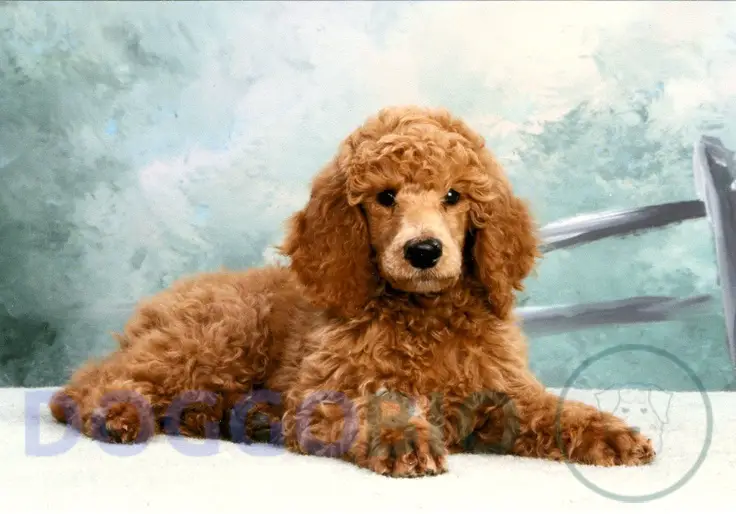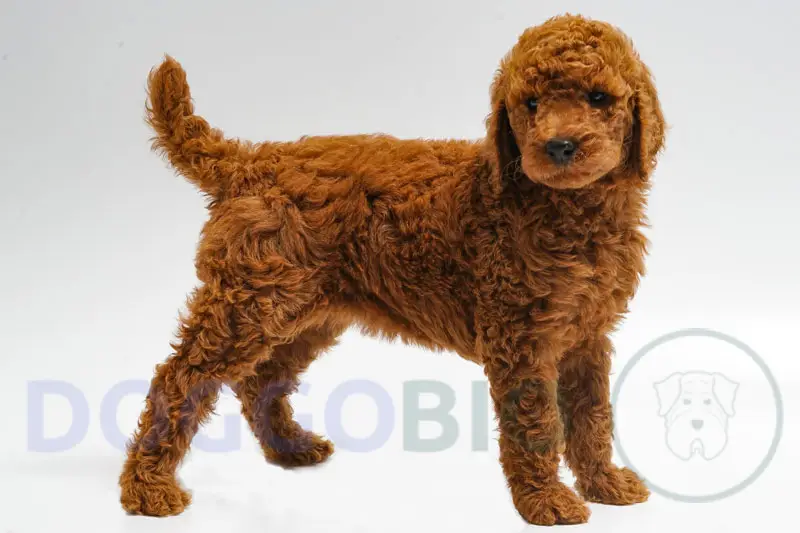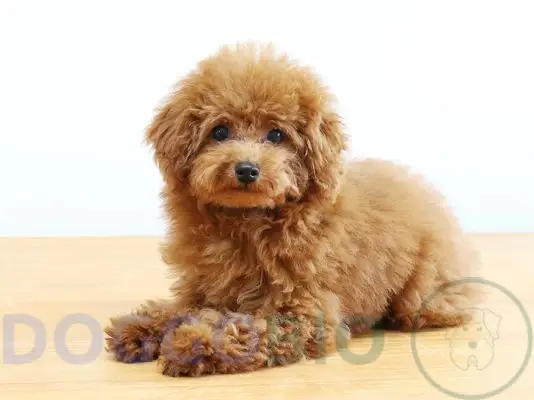The Red Poodle is a charming and brilliant dog breed that has captured the hearts of dog lovers worldwide. Known for its striking red coat, the Red Poodle is a variation of the standard Poodle, one of the world’s most popular dog breeds.
Red Poodles make lovely companions for families and individuals with their playful personalities, affectionate nature, and elegant appearance. In this article, we will delve deeper into the history, characteristics, and temperament of the Red Poodle, shedding light on why they are such a beloved breed.
What is a Red Poodle?

The red Poodle, a breed of purebred Poodle with a coat of red, has become the center of attention for many dog enthusiasts due to its rareness. The red coloring of the Poodle is said to be a result of a recessive gene called the Rufus gene, which, according to the esteemed scientist John Armstrong, is still being studied.
Although the red Poodle’s DNA is still being researched, some experts claim that the red hue is created by darkening the natural apricot or brown fur color. Because of their unique coat color, poodle breeders set extremely high prices for red-coated puppies.
What Does a Red Poodle Look Like?
These fluffy pooches look very similar to the standard Poodle breed, except for their fierce, fiery coat color that will surely catch your eye.
When you gaze into their piercing, black eyes, you can’t help but be enchanted. Their tall, perky ears add charm, and don’t forget about their distinctive mustache!
Their black paw pads, noses, eye rims, and lips set them apart from Chocolate Poodles. But the most noticeable aspect of these pups is their magnificent coat. The curls are so fluffy and red that they almost look like a fiery cloud! And the best part is that they don’t shed much at all.

Size, height, and Weight
Poodles also come in three sizes: toy, miniature, and standard.
The toy Poodle, the smallest of the three, was once used for water hunting and circus acts.
Bred initially down from the much larger standard Poodle, the toy Poodle can grow up to 11 inches tall and weigh only 5 to 10 pounds.
Interestingly, the miniature and toy Poodle varieties were selectively created by Americans, although Poodles are the national dog of France.
| Size group | Height Range | Weight Range |
| Teacup | Below 9 inches | Under 6 pounds |
| Toy | 9-11 inches | 6-9 pounds |
| Mini | 10-15 inches | 10-20 pounds |
| Moyen | 14-18 inches | 20-30 pounds |
| Standard | 15-24 inches | 45-75 pounds |
Temperament and Personality
The American Kennel Club (AKC) lists America’s most popular dog breeds. Unsurprisingly, the Toy Poodle is number seven among 194 species. Unbelievable, right?
These four-legged creatures uniquely combine intellect, humor, and athleticism, making them stand out among other dog breeds. Despite their poised and sophisticated appearance, Poodles love exploring new surroundings and spending time with their loved ones, regardless of the family’s size.
The adaptability of Toy Poodles is one of their greatest strengths, as their compact size allows them to fit easily into various home settings.
Nevertheless, as endearing as these little dogs may be, they are also quite vulnerable to injuries if handled roughly by young children. It may be prudent to wait until the kids are a tad older before bringing one of these charming canines into the home.
Training

These intelligent dogs are always willing to learn new tricks and commands, but teaching them effectively takes patience and positive reinforcement.
Make sure to have plenty of healthy treats as you work with your Poodle. They respond well to rewards for good behavior and positive reinforcement, which helps them master new skills and behaviors.
It’s essential to keep your red toy Poodle mentally stimulated and physically active for their well-being. Regular exercise and engaging activities will keep them happy, healthy, and eager to learn.
Remember to provide your Poodle with plenty of love and affection during training. They thrive on attention and positive interactions with their owners.
With the right approach, training your red toy Poodle can be a fun and rewarding experience for you and your furry friend.
Exercise Requirements
Poodles are not only intelligent but also quite mischievous. Without proper physical exercise and mental stimulation, these dogs can become little terrors, wreaking havoc with their chewing, digging, and potty accidents.
Be aware of their small size. Red Poodles still require plenty of exercise. It would help if you provided them with at least 30 to 60 minutes of daily playtime and walking.
Here’s another fun fact: Did you know Poodles were originally bred as hunting dogs? They have a strong prey drive and can easily scare smaller animals, so keeping them on a leash when you’re out and about is best.
Oh, and if you’re planning on leaving your Poodle outside, make sure it’s locked and secured. These dogs are quite the escape artists and will find a way out if they can!
Grooming and Cleaning
Red Poodles are not very prone to showing dirt and tear stains, but that doesn’t mean they don’t need occasional baths. It’s essential to use high-quality dog shampoo and frequently brush their coats to prevent mats and tangles.
Poodles are often considered hypoallergenic, but it’s important to note that no dog is truly hypoallergenic. However, their low shedding does mean that they still require regular brushing. Their thick and curly coats must be brushed at least once or twice a week and more frequently if their skin is kept longer.
Are Red Poodles Hypoallergenic?
Yes, Red Poodles are hypoallergenic. Red Poodles are recognized as a hypoallergenic breed due to their unique non-shedding curly coat, which traps loose fur, preventing it from becoming airborne. However, it’s essential to understand that no dog breed is entirely free from allergens.
In exceptional cases, individuals with intense allergies to dog hair and dander might still exhibit allergic symptoms. Nevertheless, for the majority, Red Poodles remain an excellent option for those seeking a hypoallergenic pet.
Food and Diet
Feeding your Red Poodle a high-quality diet is essential to ensure they stay healthy and energetic. The amount you provide your furry friend is determined by their size, age, health, and physical activity level. It’s crucial to follow the daily feeding instructions recommended by your vet.
If you’re unsure about how much to feed your Red Poodle, don’t hesitate to consult your veterinarian. They can help you develop a feeding schedule tailored to your dog’s needs.
While giving your dog treats is a great way to show them love, avoiding offering them any human food high in sugar, salt, or deep-fried is essential. These snacks can harm your dog’s health and lead to weight gain and other health issues.
Common Health Issues
Like any other breed of purebred dogs, Red Poodles may encounter various health problems despite being generally healthy dogs.

1. Hypothyroidism
Hypothyroidism is an intriguing health condition that Red Poodles can develop. Hypothyroidism occurs when the thyroid gland doesn’t produce enough thyroid hormone, which affects a Poodle’s metabolism.
Symptoms of hypothyroidism in Red Poodles can include a dull coat, weight gain, low appetite, and lethargy.
2. Eyes problem
Progressive Retinal Atrophy (PRA) is a genetic condition that leads to the deterioration of the retina and eventual blindness in both eyes. While some Poodles may lose their vision at a young age, PRA typically affects them later.
It is essential to have your Red Poodle regularly checked by a veterinarian to detect early signs of PRA and to prevent or delay the progression of the disease.
3. Legg-Calve-Perthes disease
Legg-Calve-Perthes disease is a canine health condition that affects the hip joints, particularly in puppies aged between 4 and 8 months. Unlike hip dysplasia, this disorder is more prevalent in mini and toy breeds. It causes pain and discomfort in the affected limb, leading to lameness if not treated promptly.
4. Hip Dysplasia
Hip Dysplasia is a condition that commonly affects heavier dog breeds, and it is hereditary. This condition affects the hip joints of dogs, leading to pain and difficulty walking. Unlike Legg-Calve-Perthes disease, which affects the femoral head, Hip Dysplasia can cause severe problems for Poodles and other breeds.
5. Von Willebrand’s disease
Von Willebrand’s disease is a genetic bleeding disorder that affects Poodles. It impairs the blood’s ability to clot, leading to prolonged bleeding after injury or surgery. The condition arises due to lacking von Willebrand factor, a protein essential for blood coagulation.
6. Color dilution alopecia
Color dilution alopecia is a dermatological condition that leads to hair loss in canines with particular color dilutions.
7. Gastric torsion
Bloat, also known as gastric torsion or twisted stomach, is a severe and potentially fatal condition that affects medium and standard Poodles. It occurs when the stomach fills with gas and fluid and twists on itself, blocking the blood supply to the stomach and other vital organs. This causes severe pain and can lead to shock and death within hours if left untreated.
How Long Does a Red Poodle Live?
Who wouldn’t want their beloved furry friend to live as long as possible? Luckily, red Poodles are known for their relatively long lifespan! While many factors can influence a dog’s lifespan, such as genetics and lifestyle, Poodles are generally blessed with an average lifespan of 12 to 15 years.
Interestingly, female red Poodles usually outlive their male counterparts by one or two years. So, if you want to adopt a red Poodle, remember that the ladies tend to stick around a little longer!
How Much is The Price of a Red Poodle?
Red Poodle puppies may come at a higher price than other Poodle colors, but it’s not because they’re better. This is because red Poodles are pretty rare and in high demand. Standard red Poodles can cost between $800 to $1,500, while miniature and toy versions start at $1,000 and go up to $2,000.
It’s important to note that where you buy your Poodle from will also affect the price. Purebred breeders tend to be the most expensive, while accidental or backyard breeders can be slightly cheaper. Puppy mills and rescue shelters have the lowest prices, but it’s always best to rescue a Poodle rather than support puppy mills.
List of dogs that are similar to red Poodle
Frequently Asked Questions
1. Are Red Poodles rare?
Yes, Red Poodles are rare. Red Poodles have emerged as one of the most in-demand colors, elevating their rarity and value.
In the USA, the heightened demand for these dogs means that locating a trustworthy breeder can be a daunting task. Some even turn to backyard breeding to satisfy the market’s needs.
The quest becomes notably more difficult if you’re in the market for a teacup red Poodle. These diminutive canines are produced by breeding the smallest puppies in a litter, making them even scarcer.
2. Can I dye my red Poodle?
Yes, you can dye your red Poodle.
While the idea of dyeing a Poodle’s coat might seem unconventional, it’s a thought that has crossed many dog owners’ minds. The primary concern is the safety and potential side effects on the dog.
Fortunately, it is possible to dye your red Poodle’s coat, but it’s crucial to use non-toxic and safe dyes, and only on Poodles older than 12 months.
However, there are risks involved. Some dogs might not show any negative reactions, but others could be allergic to the dye, leading to skin irritations or infections.
The decision to dye your Poodle’s coat should be made with their safety and well-being at the forefront.
3. Do the Red Poodles change colors when they grow older?
Yes, Red Poodles can change colors as they grow older. Red Poodles often undergo various color transitions throughout their lifespan.
When born, they typically sport a vibrant red hue, but this can either lighten or darken as they mature. Some might retain a lighter shade, while others might adopt a darker tone. It’s not uncommon for red Poodles to darken during the initial 18 months post-birth.
Interestingly, owners of apricot or tan Poodles might find their pet’s coat transitioning to red. Fading is also a prevalent phenomenon among red Poodles, influenced by both genetic and environmental factors. Therefore, it’s entirely normal for a red Poodle’s coat to evolve over the years.
4. Are Red Poodles get along with other pets?
Yes, Red Poodles get along with other pets. Red Poodles are known for their sociable nature and generally have harmonious relationships with other pets.
Originally bred for hunting purposes, they have evolved to be affectionate and amiable companions. If you have other pets in your household, it’s likely that your Red Poodle will interact and bond with them in a friendly manner.
5. Are AKC-recognized Red Poodles?
Yes, AKC-recognized Red Poodles. These vibrant-colored poodles initially made their appearance in the 80s and it took some time before they received their well-deserved recognition from the AKC.
Today, owners can effortlessly register their Red Poodles with the AKC. Furthermore, AKC Red Standard Poodles are eligible to participate in AKC-organized beauty and obedience competitions.
Conclusion
In conclusion, the Red Poodle is a remarkable breed that has become increasingly popular among dog enthusiasts worldwide. Their striking red coat, intelligence, and playful personality make them ideal companions for individuals and families.
Although they require regular grooming and exercise, the love and loyalty they bring to their owners make it well worth the effort. Whether as a family pet, a therapy dog, or a service animal, the Red Poodle has proven to be a versatile breed that excels in a wide range of roles. With their affectionate and outgoing nature, it is no wonder that Red Poodles have captured the hearts of so many.

Pingback: Phantom Poodle: Diving into the World of Unique Coat 2023
Pingback: Parti Poodle: Dive into the World of this Breed 2023
Pingback: Blue Poodle: Discovering the Unique of These Canine 2023
Pingback: Merle Poodles: Interesting Facts You Need to Be Aware of 2023